Description
My goal is to build a real-time multiplayer game that contains a persistent online ecosystem. The goal of this article is to outline a detailed “what” and “why” for this project, and chronicle where it takes me.
Play the Live Demo
Multiplayer 🎮
A series of “worlds” where many players are each given a body to occupy space in the world. Those bodies will interact with the world and each other, but I don’t have many opinions on the nature of those interactions. The gathering and exchange of information? Building structures?
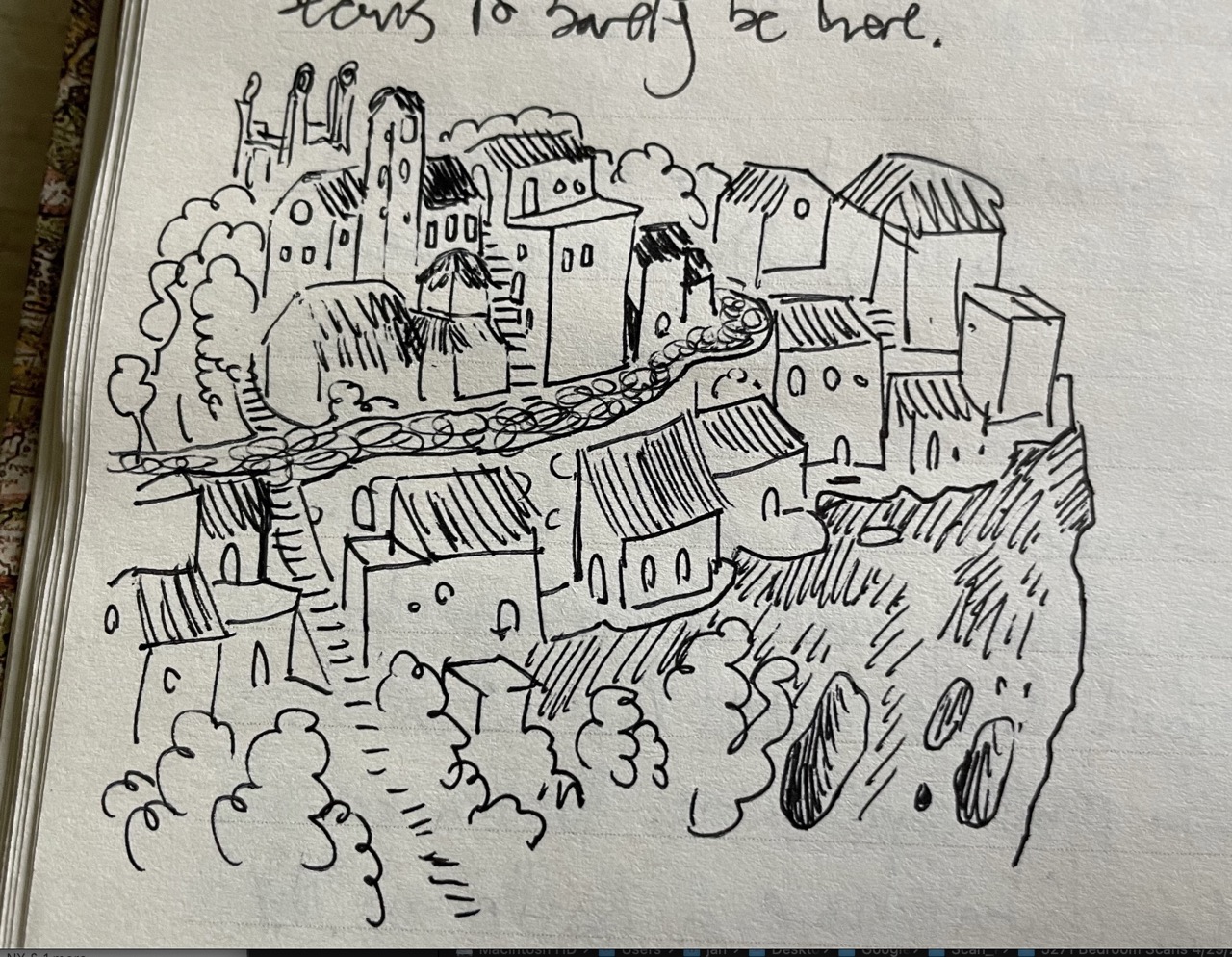
A drawing of a town inspired by the innovative Townscaper, an ambient town-building game.
Open World 🌍
Open World: each “world” is a continuous space, although it may be broken up by geographic features, and generative mineral distributions. Flora and fauna make up the living terrain of these places, and each organism has physical properties that allow them to interact with both one another as well as human players.
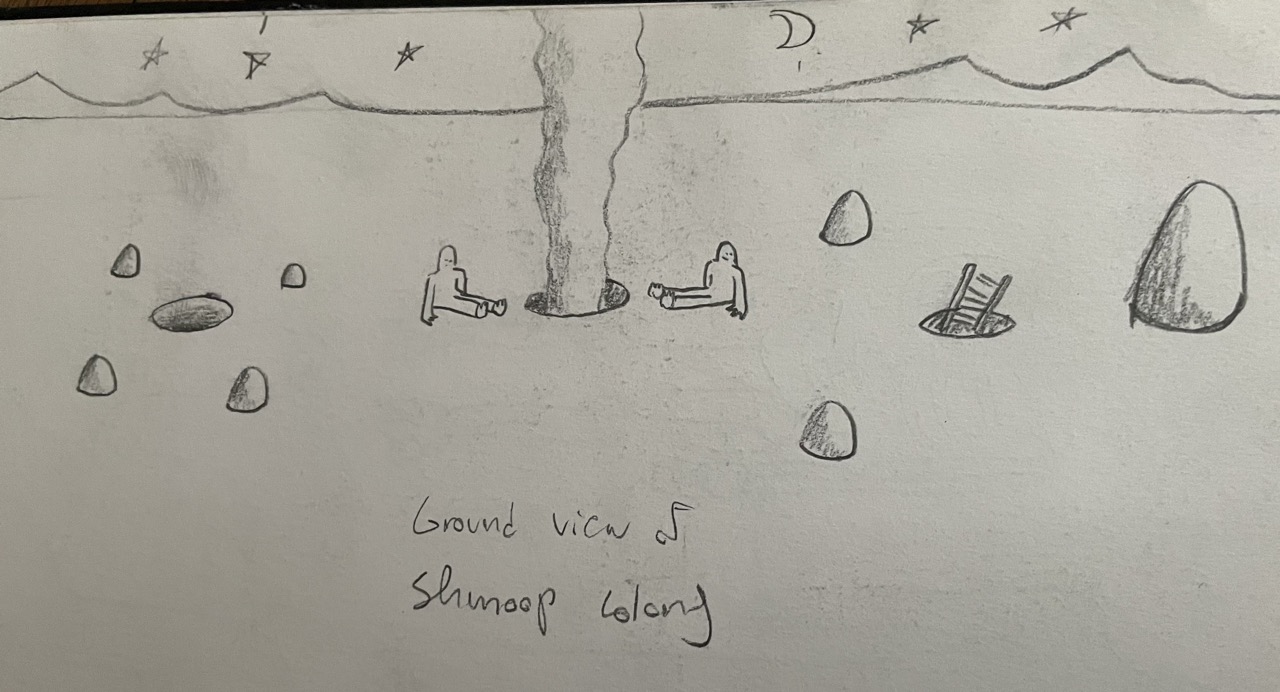
Sketch of a desert race of Shmoops, with behavior not unlike that of Meerkats or Prairie Dogs
Ecosystem Simulation 🌳
But this behavior is not static. Through the interaction between organisms and trophic layers, not only do population distributions of organisms throughout the world change over time, but the makeup of each organism does to due to an abstract genetic system.
Check out an older experiment I made in unity
Here’s an early experiment in this idea - here’s some vegetation, but check back soon for a build with some herbivores
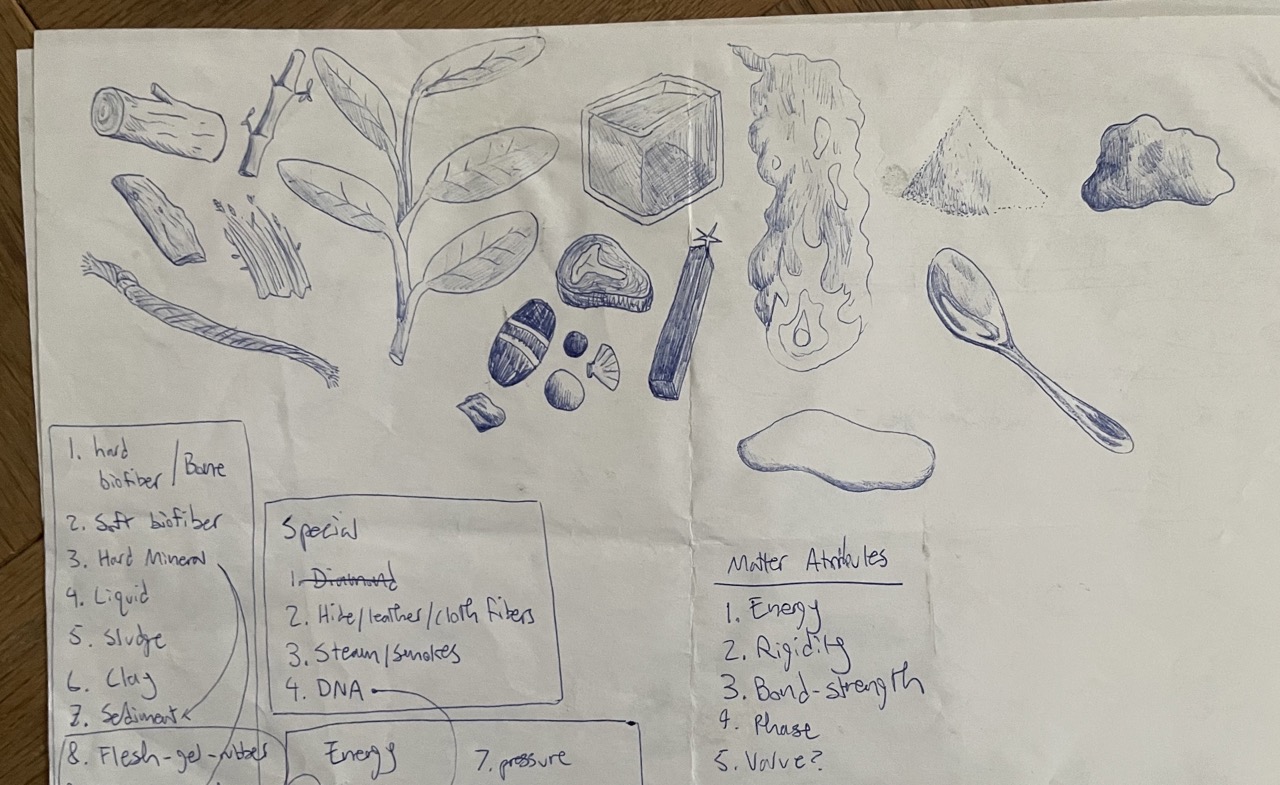
A sketch I made while thinking about reducing physics and chemistry into toy-like abstractions
Abstract Laws of Physics and Chemistry 🧪
Here’s the thing about ecosystems - if they aren’t based on immutable laws, they will be biased to select for unlimited power [until the world implodes](https://en.wikipedia.org/wiki/Akira_(1988_film). they have to be based on immutable rules. One creature would evolve to have “1000K strength” and eat us all. Physics IRL, especially the laws of conservation of energy and mass, requires a cost in exchange for every allowance. For my purposes, the laws themselves matter less than their consistency.
Persistence and Time 🕰️
Arguably the most popular lifespan structure of a game is this:
- Begins when players join
- Ends when they leave But I’d like to create a world that originates far before any player joins, and continues regardless of whether anyone is around. This is what makes the real world so mysterious and wonderful. Hopefully, this structure allows for games to occur within a world, rather than for the world to be the game. Possibly relevant: SIMON SINEK: Finite vs infinite game
Environmentalism and Ecological Sustainability 🍃
this is pretty loose. I don’t know if I believe that games can mitigate the effect human beings are having on this planet, and of mass extinction and destruction of natural habitats of once beautifully complex ecosystems. If anything, it is a celebration of them. I think there is a dark beauty in seeing how fragile they are and in allowing the players in this game to destroy and alter these systems, if they choose.
Other Thoughts
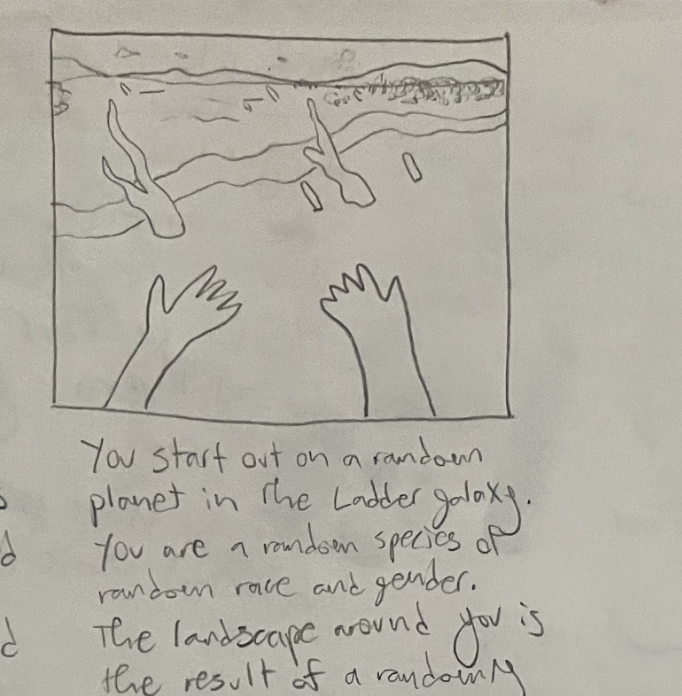
Sketch of the cosmic existentialism of birth into a 1st person view, somewhere.
POV: RTS games are generally third person, and first-person are usually, you know. I think that a hybrid of the two would allow for an interesting intersection between individual and society-level gameplay. experimented a bit with implementing this hybrid here Time played constrains: Fundamentally, a world that is “always on” and has any structures of competition will incentive more play. I don’t believe in creating this incentive. To get around this, I’m considering imposing time constraints for players, only allowing the game to be played for a certain amount of time each day
Previous Projects 🐇
Here is a screenshot from an ecosystem simulator I created in the game engine Unity. You can see bunnies with lifespan and reproductive timer bars floating above their heads. They continuously scan their surroundings for grass, and, if their reproductive bar is full, other bunnies. Their visual sensory perception is relatively organic, composed of a scattered slew of ray tracers detecting what objects are in front of them in the hopes it would create interesting and organic behavior.
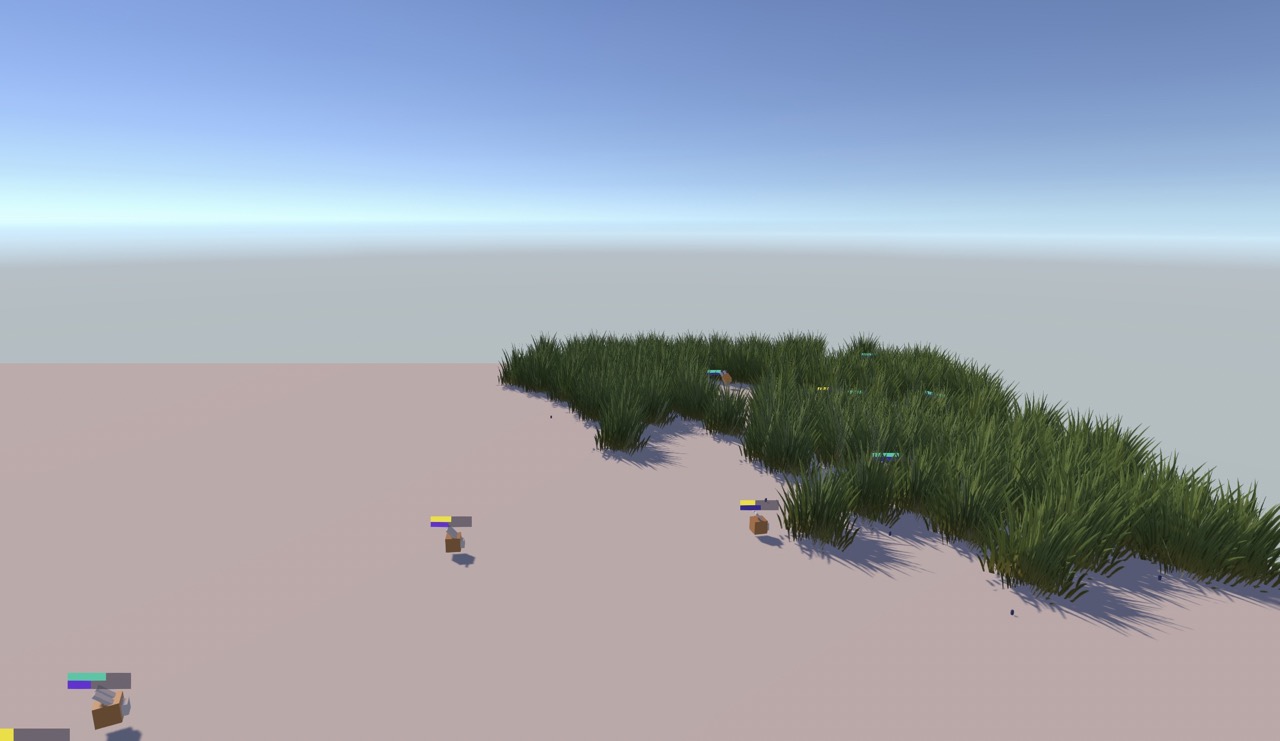
Sorry, I haven’t deployed this.
Inspiration 💡
- RTS games like Age of Empires, Age of Mythology and Black and White
- Spore, an incredibly ambitious game that was as innovative as it was flawed
- Conway’s Game of Life and Cellular Automata as a whole
- John van Neumann’s question of whether a system can create itself (a matter for another blog post)

Single cell organism stage of spore

Wild Ideas 🐗
Leveraging Distributed Databases: Maintaining an ecosystem on a server is computationally expensive, and could be hard to scale horizontally if more and more users are interacting with the same world and the world is becoming more and more complex. Distributed databases might offer some interesting and creative solutions to this challenge, if the game is every computationally expensive enough for this to be necessary.
Process: Part I
May 24: Getting Started
I started with a basic socket.io implementation on the server and the client.socket.io on both the server and the client. At first I found the structure of their documentation slightly confusing, but figuring out how it was broken down between client and server docs:
Server
Client
The client code could look something like this:
import { io } from "socket.io-client";
const socket = io("ws://localhost:3000")
socket.on("connect", () => {
console.log("Connected")
console.log(socket.emit("player joined", determinePlayerId()))
});
socket.on("disconnect", (reason, details) => {
console.log("The server disconnect", reason, details)
});With a server like this:
// Minimal Server
const { createServer } = require('http');
const { Server } = require('socket.io');
const httpServer = createServer();
const io = new Server(httpServer, {
cors: {
origin: "http://localhost:5173",
methods: ["GET", "POST"]
}
});
io.on("connection", (socket) => {
console.log("Connected")
socket.on("player joined", (playerId) => {
// do something when connection begins
socket.on("disconnecting", async(reason) => {
// do something when connection ends
})
})
});
httpServer.listen(3000);I also tried the websocket library that’s shipped with all browsersbut I found that socket.io had some useful features I didn’t need to reinvent.
On top of this super basic handshake,
- I rendered a grid of divs
- gave a player a UUID and random location when they first visited the URL
- Saved that player’s UUID so their location persisted across visits
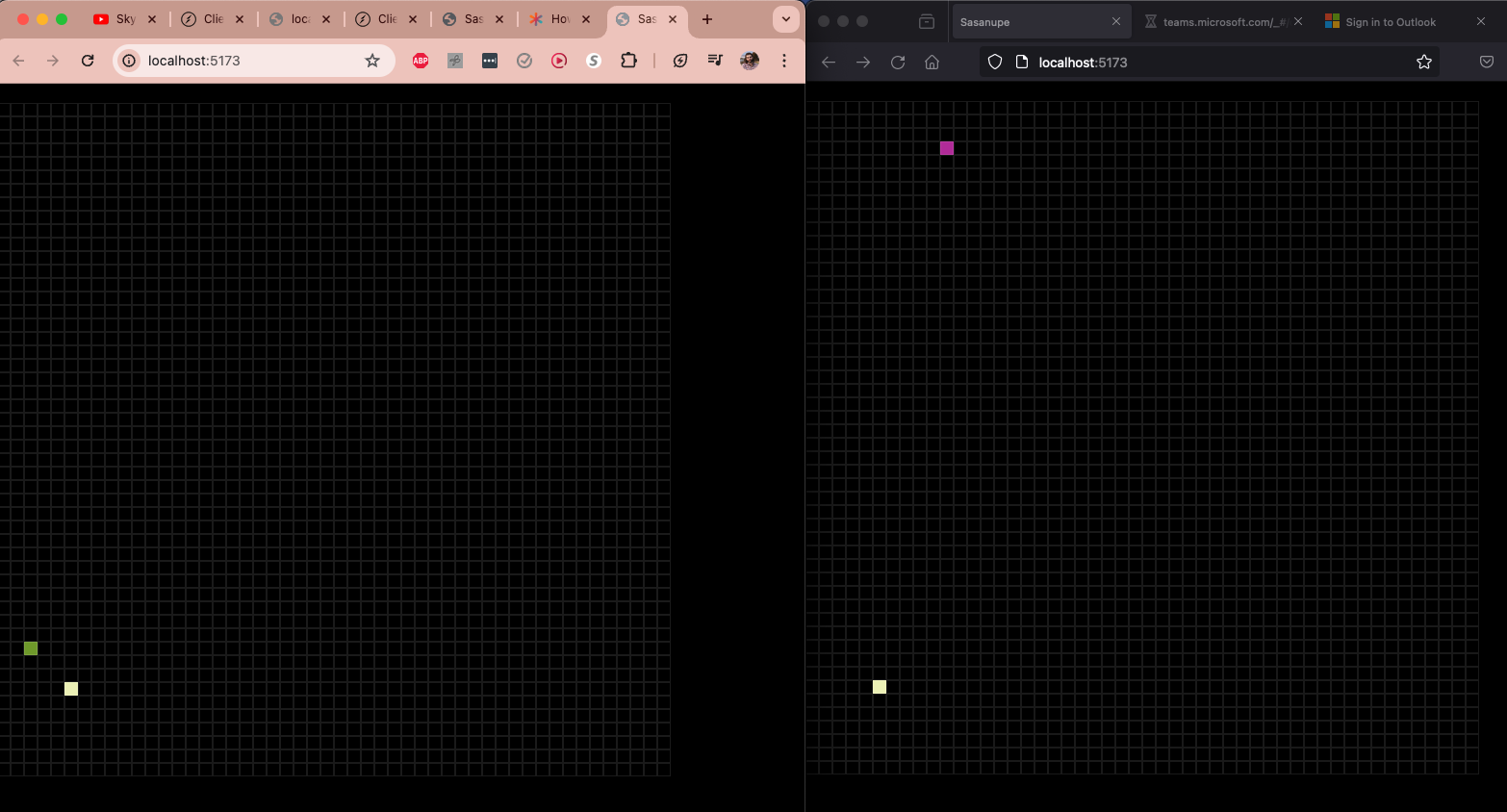
Once I was content that I had the beginnings of a multiplayer system, I impatiently moved onto the ecosystem. Here are some “plants”!
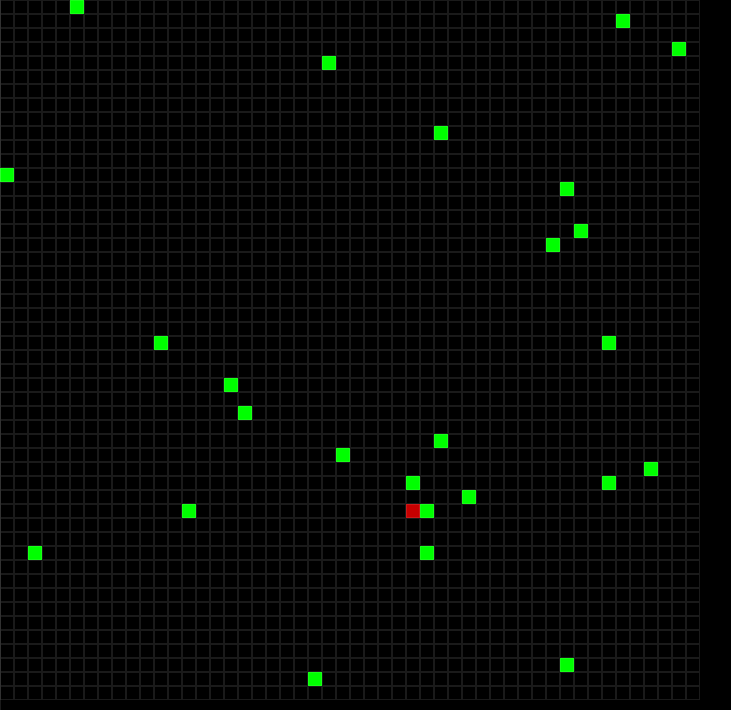
Each of these is sent as a class instance every second.

I gave each object some “reproductive” behavior, which actually looked more like movement.

It seemed like each moss should have multiple children, so I messed around with the generation size:
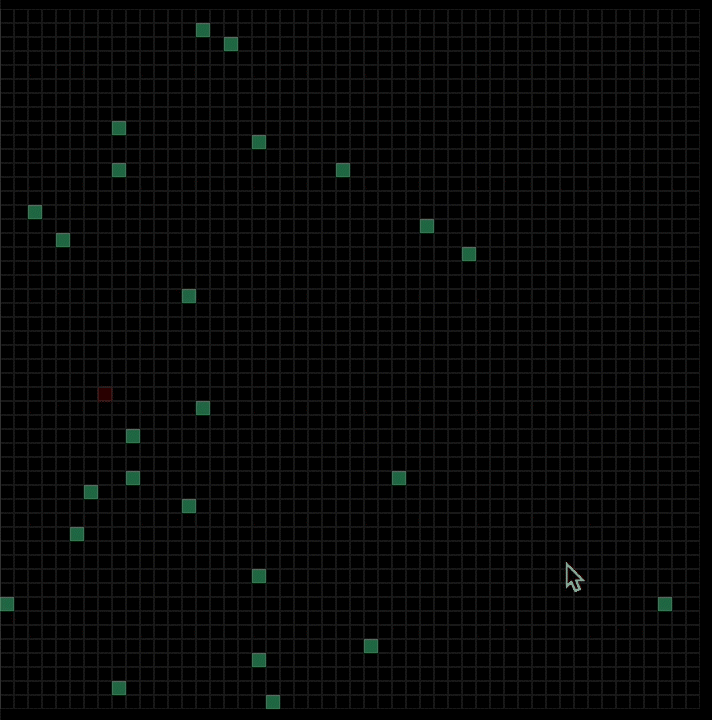
May 26: Optimizations
Then things started crashing. Originally, I passed every object to the client, which was a bit silly. I refactored in a few ways.
- Only pass the color per square
- only re-render divs that need to change
- Added an accompanying object with references to each object in their location in addition to the double-nested array/grid structure, which allowed for much cheaper iterations through organisms*
- Creating a set of class inheritance to describe organisms, like BaseTile > Organism > Moss
I couldn’t do away with the double-nested array/grid data structure though, because it was the best way to ask things like “what is next to this square?”, as in “can I move here?”
Ideas for feature refactors
- only send the data for the diff of the board, since much of it is empty (at least at the “beginning” of a “game”) - Courtesy of the wonderful Wolf Mermelstein
- Create a way to send a raw buffer of data, minimizing representations of color even further. I could decide to work with just 16 colors, for example, allowing me represent two squares with just a byte.
- Use a memory-safe language (bit of a knee-jerk with understanding what memory limitations I may be facing first, if any)
During this refactor, I learned something very important about declaring arrays. I wrote this line to create the empty grid like this:
initializeGrid(){
// this.cols and this.rows is just the number of rows and columns.
return new Array(this.rows)
.fill(new Array(this.cols)
.fill(new Array(2)
.fill(0)))
}What I intended to do was to create an array (rows) of arrays (columns) or arrays (multiple slots per square).
But when I added a player to one of the squares like this:
this.grid[x][y][0] = {
id: playerId,
position: [x, y],
color: generateRandomColor(),
online: true
}This is what I got:
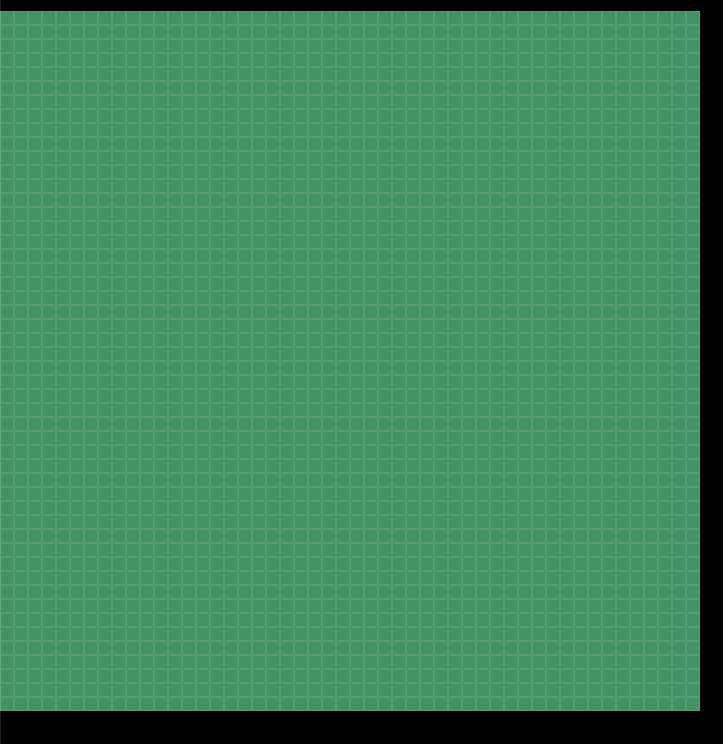 Not really desired behavior.
Not really desired behavior.
The problem was that the .fill method was simply filling each index with the same array, at every level of this set of nested loops!
It’s chunkier, but this was the solution:
initializeGrid() {
const grid = [];
for (let i = 0; i < this.rows; i++) {
const row = [];
for (let j = 0; j < this.cols; j++) {
row.push([0, 0]); // Create a new array for each cell
}
grid.push(row);
}
return grid;
}Maybe I can get the podcast 99% invisible to sponsor this project.

May 28: Organism Behavior
Oof. I was disappointed to find that when I refactored the moss into a class inheritance system, the behavior didn’t hit the same, so I ended up playing around a lot with it. It also DEFINITELY was still crashing, probably because the cycles of reproduction per generation were so dramatically in sync.
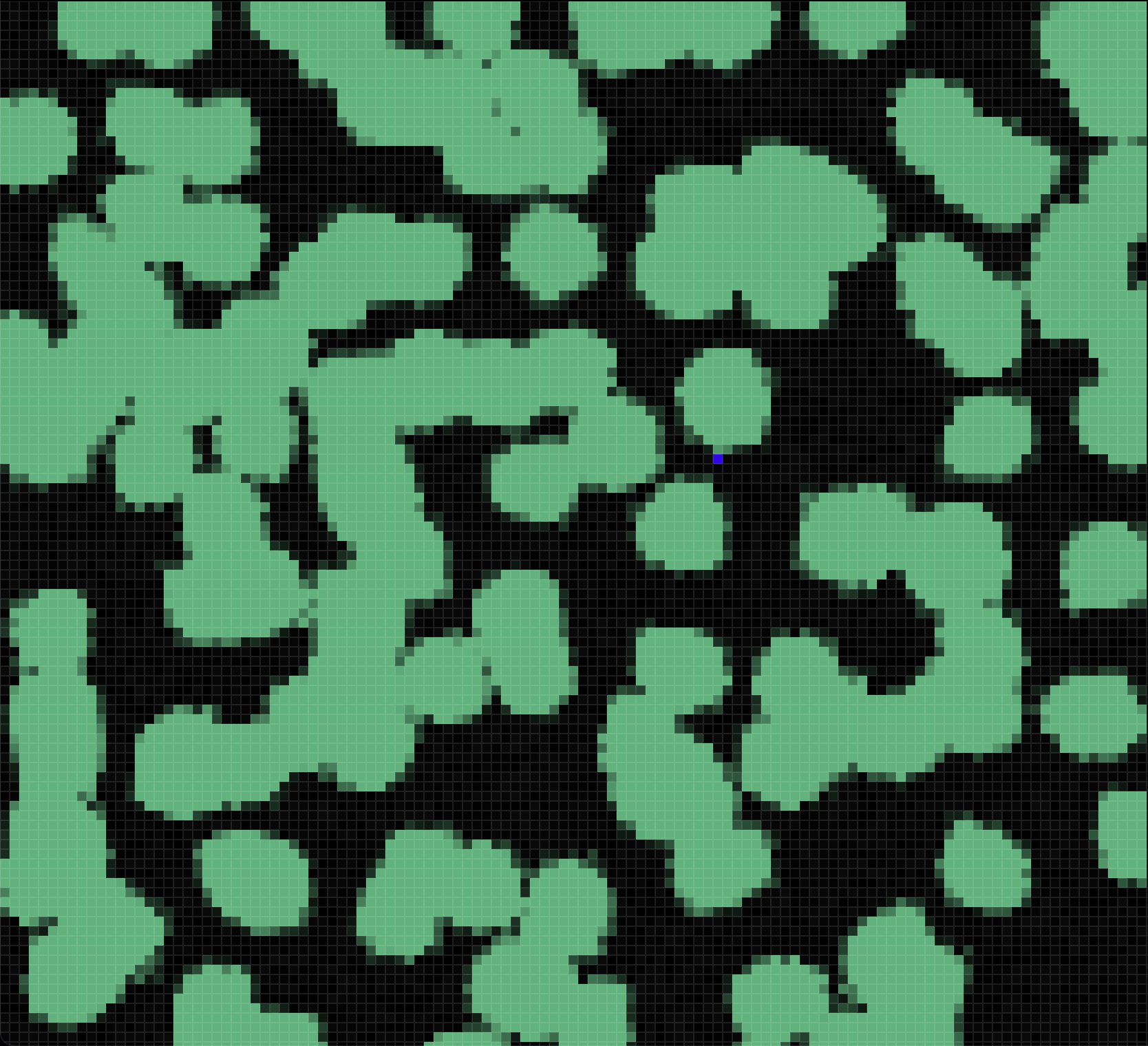
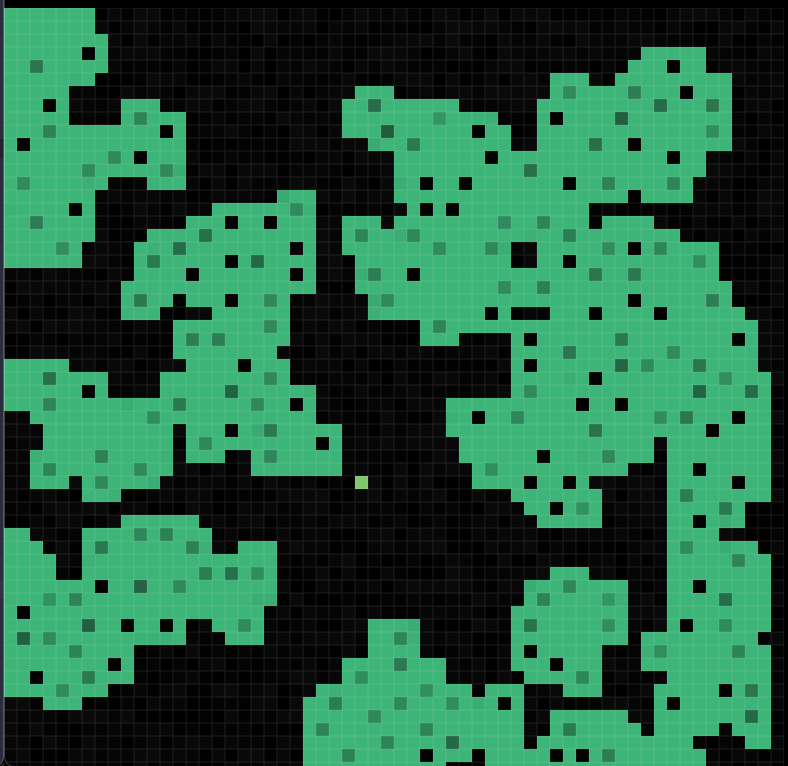
Still faced with a lot of latency, I talked with my peers and found that there are many ways I could tackle my latency challenges:
- Leverage the GPU for better performance
- Use WebGL for more efficient rendering than the DOM can provide
- Use Web Assembly for more efficient CPU usage than the browser can provide
- How a machine language like Rust or Go might really help with performance because garbage collection (cleaning up references to now unused items) might be very important
- Big 0 notation and understanding how different iterative structures really effect performance
I also discovered which organism properties had the most interesting conway-ish effects.
- The reproductive window of maturity moss could reproduce within
- The ability for moss to reproduce “OVER” neighboring moss
- Number of times a moss reproduced per generation
All this said, the most rational thing to do seemed to be to open up the Node profiler for the first time. Hello Node profiler!
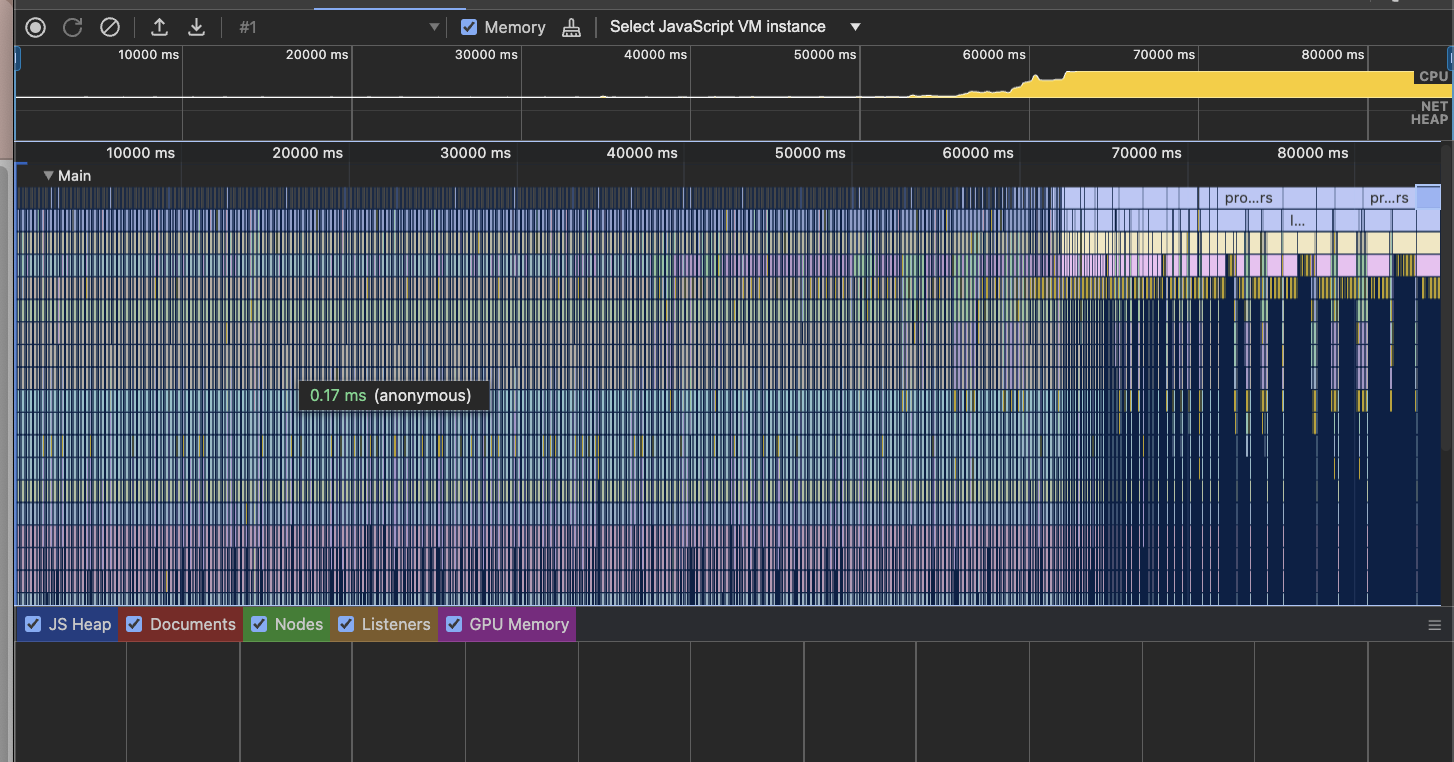
It wasn’t the biggest revelation, but the draw calls were certainly surpassing the amount of time allotting to the frames they were called in. So the easiest way to kill latency would probably be to just simply slow down the reproductive behavior, or make it slightly more diffuse over time (less synchronized). Luckily, these happen to be things that really make sense for plants anyways. I hope to return to many of these optimization opportunities above, but they also each have the ability to kill the project by making it into an optimization project instead of a game.
May 29 : Talks
I have been recommended this concept/article: How to make a simple entity-component-system in C++
And reminded of the brilliant Sebastian Lague, a youtube artist/gamecreater/programmer who creates videos about stuff like volumetric cloud generation.
I paired with Seamus Edsontoday and discovered he’s one of the best possible peers I could have when working on a project like this. I told him about wanting to use Three.JS for this project at some point, and he gave me some nuanced advice. On the one hand, he showed me a game he created with a colleague called Lost Lots which sort of made me feel like, I don’t even need to do this project because he did such an incredible job on something so similar. He created an incredible abstract chemistry system governing the laws of his plants.
But he also counseled me that, I didn’t need to go 3D. Much of my concept really doesn’t require 3D, and would actually be slowed down by the complexity 3D would introduce.
Peter Stefek mentioned this site in which each cell on the grid has behavior determined by a neural network.which was interesting, but probably not relevant since the thing most like a neural net in my game will really by the generations organisms themselves. However, it opened up a cool conversation. Carsten wondered if a neural net thing could be use for tuning the model itself, sort of similar to how Yannick used combat simulations in his game to determine the difficulty of an enemy. He also pointed out that a point and click movement system is much less demanding than a square-by-square “WASD”-style input system.
Note: Peter rewrote an implementation of the Game of Life on ShaderToy that I would really like see.
Reed framed this type of decision as a rung on a ladder of abstraction. This is a ladder of abstraction because the spectrum we’re talking about is the spectrum of intent - what is the person intending to to, and you can go one step further on spectrum where you just declare the intent of the actor He also pointed out I should probably figure out what kind of player interaction I am going for:
- Human interaction time
- How does a player choose what action to take? Can they add nutrients, or take it away? How does it work? Do they need to select a menu item which takes a while?
Carsten also asked - do you play as a “human”, or as a plant? I love this question.
Carsten also asked, can a single square on the map contain multiple things? How does my data model describe space, and stuff in space? I have some reflections on this I wrote down in my journal I ended up writing down much later.
Yannick, meanwhile, is interested in player interaction with the evolution of other organisms; breeding. Maybe even training pets?
At some point somebody showed me this crazy cool game called lichenia, a really beautiful grid-based game.
To conclude, here’s a thematic idea - what if there are human beings and you play as animals to destroy their civilization? Misanthropic, but a neat turn table.
May 31: Alex Chen
Alex Chen has created a very performant multiplayer top-down shooter game between a bunch of colorful bubbles using a custom implementation of UDP.
Here are some articles he sent me: Creating a first person shooter with one million players Choosing the right network model for your multiplayer game
June 18: Rust / Deployment!
That past couple weeks have flown by. I spent much of one week creating this during a gamejam and a lot of the second week working on my Gauntlet , which started during Impossible Day (where Recurser’s try to do something impossible) and quickly became something I wanted to continue working on throughout the week.
This week, I am working on deployment. I did it actually! Here is the live Demo of what I have so far! This was deployed with Heroku. I made it pretty far with dockerizing and deploying with the community disco server as well, but couldn’t quite get it just yet.
Rust and WASM: I tried out Web Assembly and using it to compule Rust to the browser in the hope that at some point I can port much of this game to rust.
One really reassuring part of the Rust community (besides all of it) is that one of the most popular “Hello World“‘s is actually an implementation of Conway’s game of life!
Process: Part II
June 19: Overview
Project Structure
Okay, I’ve deployed something, so I feel more comfortable walking through the project and trying to improve it a bit in its current state.
// Directory system
- server <--- Node.js server
- client <--- vite client bundle
- package.json
Deployment to Heroku
Here’s how to deploy to Heroku since I didn’t document that the first time around.
This is my top-level package.json file, which references two more package.json’s that live in the client and server dirs, respectively.
"scripts": {
"start": "npm run build-client && npm run server",
"build-client": "cd client && npm i && npm run build",
"server": "cd server && npm i && node server.js"
},
// Note there are also package.json files in server and client directoriesAt this point I should probably be using docker, but this Heroku process works and I want to keep moving.
I actually have omitted the Procfile Heroku sometimes wants because without it, Heroku defaults to a web process running npm run start, which is exactly what I want to do.
Here is a snapshot if the repo at this stage.
Here are two guides I used to deploy with Heroku
One gotcha I faced: Setting your node version in you package.json is very important, and making sure it lines up with version you’re using locally and remotely.
# $create a heroku remote
heroku create -a example-app
# Check it was created correctly
git remote -vNote: This won’t work for an existing app that already has an origin. To do that, run:
heroku git:remote -a example-app
And then push to your heroku remote with:
git push heroku main
And in theory, your site should be live.
Three.js Experiments
Woah three.js is really fun. I ended up making these sort of sculptures by accident as I was figuring things out.


June 27th: Lessons in Memory
I’ve been looking into Memory profiling and this video from 11 years ago was not only helpful in showing how chrome dev tools can help with that but also had a really great primer on how memory is handled by the browser to begin with.
June 28th: Performance
I demo’d this project a few times which was really exciting:
Afterwards, I dealt with some lower-hanging usability and performance issues, and got to around this status:
Reasonable performance in the browser with multiple players: ✅ Performance on mobile: ❌ (crashes after about 10 seconds) Well-managed Memory: ❌ (there are memory leaks in the clientside) Live demo: https://jungle.rcdis.co/
I ALSO got help from the invigorating Greg Sadetskyon deploying a containerized version of this project through our disco community server in addition to my Heroku deployment just to see how it faired. Serendipitously, Greg’s keyboard output was configured differently, resulting it what can only be called “The Zoomies”. Surprised and excited by this movement behavior, I added sound and some post-processing to heighten the zoomies:
This gameplay is too fast-paced for what I’m going for and isn’t really doing anything for performance, but it was fun to experiment with. I kidn’t kill my darlings though, so for now, I just added a “fun mode” button.
Some Links
Three.js Optimization - Best Practices and Techniques | Pretty thorough video on best practices for optimization Intro to React Three Fiber The Study of Shaders with React Three Fiber
July 9th
Good things! It was a lot of work but I seriously optimized the project in the following ways:
- Instead of sending the entire world state every time it changes, only the relevant change is being sent
- Instead of tearing down and recreating most rendered objects in the scene, I am binding objects with their representation in state, and physically moving those objects in the scene accordingly.
August 15th
Kevin Saldaña pointed out that creating geometry is one of the most expensive operations ThreeJS can do
Yeah I knew that Kevin - that’s why I created a pool of reused geometries whenever one stopped being used, like a pool of
And that you can re-use the same geometries across multiple objects
WAIT WHAT. Somehow I missed that part. So although I’d been given this advice before, I didn’t actually understand it the first time around.
I went in and made sure that all tiles and boxes were re-using the same redundant geometries! This helped performance.
I also implemented a logger:
import fs from 'fs';
import path from 'path';
import { dirname } from './utilities.js';
class Logger {
constructor(logFilePath) {
this.logFilePath = logFilePath;
}
log(message, level = 'INFO') {
const date = new Date()
const timestamp = date.toISOString();
const timestamp2 = date.toLocaleTimeString('en-US', { hour12: true, hour: '2-digit', minute: '2-digit', second: '2-digit', fractionalSecondDigits: 2 });
const logEntry = `[${timestamp2}] [${level}] ${message}`;
console.log(logEntry);
fs.appendFile(this.logFilePath, logEntry, (err) => {
if (err) {
console.error('Error writing to log file:', err);
}
});
}
info = (message) => this.l(message, 'INFO');
warn = (message) => this.l(message, 'WARN');
error = (message) => this.l(message, 'ERROR');
}
const logger = new Logger(path.join(dirname(), '../../app.log'));
export const log = logger.log.bind(logger);
And I’m hoping that this will help me track down issues where the app is crashing on the server, which I have noticed before when loading it with a ton of people.
As I return to this project, I will take my time to write consistently formatted, information rich messages. I really like this approach because it means that I am using a single line to line to standard out AND to a file on the server.
However, if the server is restarted, this may not work. Ideally, I could find a way to send the log file out somewhere, or possibly a way to persist this file on the server even if the server crashes.
I’ve taken a break from this project for over a month, and in the interim I decided that
- To continue forward, I should decide on the concrete problems with the games performance and concrete goals for the game I want to achieve (I.E an actual GDD)
- I have realized which major optimization scan be made
- Not rendering each tile as a geometry
- refactoring slightly so that only the local world information is sent from the server, which will reduce the “startup” bottleneck I’ve found
- I’ve found that user testing is a joy, players always find a way to to make a game out of very little, and this testing is superior to automated testing in many ways
- The game is actually very performant now, I just don’t know up to how many people
- Some issues with the game’s experience actually may have been confused for lag - there is a single column, column 25, where, if the player is on that column, the camera doesn’t move, which may feel like lag
- Using Keydown saved me the work of debouncing the keyup input, but it leads to a less responsive feeling, and I should use keyup and debounce instead
- I could port the game’s backend over to rust or go, and I could use React 3 Fiber for the frontend, and I could even write parts of the game’s frontend in rust or go using WASM, but these things are very time consuming and probably best left for another time - they are great coding experiments, but offer very little in terms of actual results, and I think it would be demoralizing to potential fail at just returning to where I am at now
- After my experience with studying algorithms and data structures more formally, I think that there are many opportunities available to redesign the backend to be more performant by using tree structures to store data and more sophisticated search algorithms to retrieve it. I’d really like to sit down with those options at some point.

- Being minimal and intentional with my color schemes would go a long way in terms of a visually unified experience. I was really inspired by the art direction of this on-the-chain game I saw at the Show and Tell event of a Brooklyn based game development Collective called Gumbo last night:

From the game Dope Wars by the Web3-leaning Cartridge Studios
This game’s art is so beautiful, yet uses only two colors and manages to evoke a variety of values using sophisticated dithering and textures. I think…it might be 3D modeled? Or reference 3D models? Either way, it’s good old-fashioned talent.
I’ve also had a lot of success with my Figma Plugin that creates pixel art, which also doesn’t require many different tones to make art:

And this theme ties into programming. If I were to simplify the colors, I could create a key to a minimal color scheme, requiring far less information to be transferred from server to client and back.
Actually, two other stories arrived in my life that contain the same theme of bitwise state:
- Nolen Royalty’s blog post about how he made 1000 checkboxes
- My brother’s story about how facebook logins are actually stored using bits in a single bit array because that’s really cheap to store and query.
TLDR; I am fantasizing about getting down to the lowest levels with this some day. Also, that’s probably not really necessary for me to continue with the game so I’m going to hold off on it for now, and get by with smart user testing and less throwing-babies-out-with-bathwater-type bug fixes.